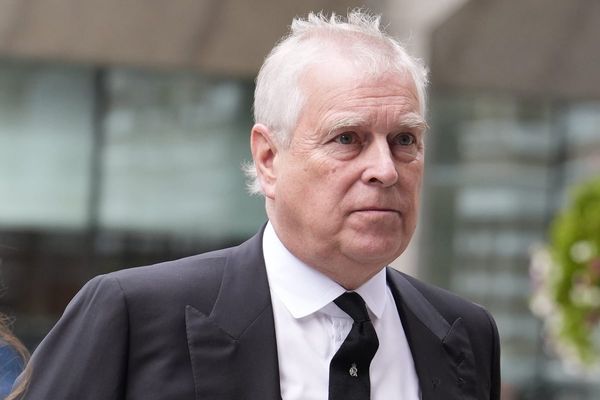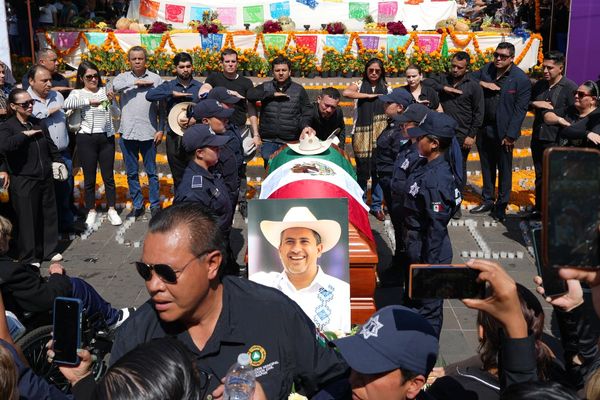
In Shevchenko City Garden, in Kharkiv, eastern Ukraine, there is a new memorial to the children killed by invading Russians. Officially unveiled this summer by the first lady, Olena Zelenska, the bronze assemblage depicts a young boy and girl in the guise of angels, apparently embarking on a winged ascent to heaven. To my taste, it is a triumph of kitsch, whose sentimentality is out of step with the profound tragedies it commemorates. Still, when I visited, little offerings of toys had been left at the statue’s base: evidence that many people disagreed, and found it a useful focus of contemplation.
Ukraine’s landscape of memory is in a state of flux. On one hand, history is being rapidly reassessed. While many public sculptures in the capital and other cities are sandbagged and protected from missiles, Pushkinopad, or Pushkin-fall, is the name given to the steady removal of statues of the Russian poet from Ukrainian streets and squares. Over the past century, the author of Eugene Onegin has been so thoroughly appropriated as a metonym for the Russkiy mir, or Russian political and cultural space, and so consistently instrumentalised as a marker of Russian power and influence, that he has fallen foul of new Ukrainian decolonisation laws. Pushkin Park in Kyiv, for instance, is now Ivan Bahrianyi Park, named after the 20th-century Ukrainian novelist and dissident.

On the other hand, the recent past pushes forward with all its grief, a visceral need for mourning, and insistent demand for remembrance. When people are killed and cities mutilated, the understandable tendency in Ukraine is to patch up urban environments as swiftly as possible, though it can feel strange when the external signs of violence are tidied away so resolutely that no trace remains. You might easily imagine that “nothing happened here”. When a cruise missile hit an intersection in central Kyiv in October last year, killing several people, the cratered highway was repaired 48 hours later, leaving what was at first an obvious black square in the road. Now the place has become a near-undetectable darkening in the asphalt. Every time I passed it, when reporting from the city this autumn, I thought of the fathomless, mysterious Black Square, the great Ukrainian artist Kazimir Malevich’s pioneering work of abstraction.
But still, in a context in which misinformation from the Russian propaganda machine is rife, Ukrainians are finding ever more inventive ways to render with irrefutable accuracy the grim reality that “everything happened here”. Irpin, the commuter city west of Kyiv that was occupied at the start of the full-scale invasion and was the scene of horrific killings, is the home town of Artem Ivanenko, a CGI and visual effects specialist for film and TV. Lately, though, he has been immersing himself in photogrammetry, which uses thousands of photographs to create high-precision 3D maps of spaces. He is using the technique to build tremendously detailed, incontestably accurate digital models of damaged buildings before they are renovated. It is partly a matter of collecting evidence, he says, and partly “to preserve in the memory what happened”. His images have been the basis of an immersive installation, seen this year at the Cannes and London film festivals – a novel means of trying to bring home the effects of the war to outsiders. In his work, evidence-gathering and memory-keeping shade together.

As the war grinds on without any conclusion in sight, it is not just in Kharkiv that Ukrainians are building memorials to those who have been lost. In Vinnytsia in central Ukraine, 29 people were killed by a strike on the city centre in July 2022. Only a year later, a memorial was unveiled, each victim symbolised by a dove. “I don’t like it as art,” said a friend of mine, a Vinnytsia native, “but people needed something now, and they can’t wait. This is a war we’ve had to fight in trainers, not military boots – we haven’t had the luxury of time and preparation.”
In Irpin there has been a public debate about how to commemorate the events there. A Kyiv architectural studio, Balbek Bureau, came up with the concept of stabilising the ruins of the blown bridge over the river Irpin, leaving them in place alongside its newly constructed replacement. The idea was, said architect Slava Balbek, who is also a volunteer in the armed forces, “to retain a fragment of the war”. But the idea was not universally popular, and there are no immediate plans to make it happen. “One lady from Irpin told me: ‘I’m living in a half-destroyed building, and I don’t want to see a destroyed bridge,’” he said.
To me, the most meaningful and touching memorials in Ukraine are the improvised, the impermanent and the spontaneous. In the tiny village of Kamianka, near Izium in eastern Ukraine, I was struck by a memorial to Maksym Buhyra, a Ukrainian soldier who was killed on this spot in 2022. It consists merely of an A4 colour printout of his portrait, along with his name and dates, tucked into a clear plastic sleeve and fixed to a telegraph pole. A Ukrainian flag hangs above and a couple of candle holders have been placed below. The villagers take care of it and treat his name with respect, recognising that he fought for them and their homes. His brothers in arms come here to mourn him.
Similarly informal, similarly heartfelt, is the shrine that has sprung up on the site of the Ria Pizza restaurant in the eastern city of Kramatorsk, which was destroyed on 27 June by a missile strike that killed, among others, the writer and war crimes investigator Victoria Amelina. Here people have left photographs, flowers, candles and even cups of espresso and cigarettes for the waiters who were killed – a memory of the small rituals that colleagues once shared between shifts. There is no grandeur or pretension in such fleeting tributes. But there is dignity, and there is love.
Charlotte Higgins is the Guardian’s chief culture writer







